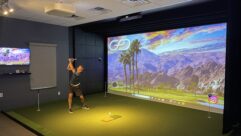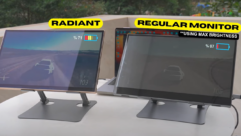If a buddy asked me if I wanted to try out their new flight simulator, I’d be pretty excited. I’ve never piloted a plane before, and what could be more wonderful than soaring through the clouds as I please, all from the comfort (and safety) of terra firma. If the buddy in question was Alex Shakespeare, however, my virtual journey into the endless blue would be a bit different than I expected.
Last year, Alex Shakespeare went viral with his Window to the World, a home rigged “window” that livestreamed different views from around the world, controlled by an adorable miniature airplane magnet on a world map. This time, Alex has used his AV engineering expertise and mad scientist streak to create a pleasant, if not mundane, take on a “flight simulator.” No massive windshield or complex pilot controls here, just three airplane seats, an overhead control panel, and a window to look out on your plane’s descent to your final destination.
The overhead control panel is the genuine article, taken from a decommissioned plane. Powered independently of the other components, the panel includes the usual suspects: a fan with multiple speeds if your flight feels a bit too stuffy, overhead lights, an assistance button (complete with the familiar “bing bong” sound effect that plays through all the Google speakers in the house), and lastly a button that hides a bit of an Easter egg. When pressed, this final button plays the fanfare that is broadcast in Ryanair flights when a plane lands on time.
On the outside of the cabin, a control panel (powered by a Raspberry Pi) allows the user to select their preferred destination. Choices include various airports in Hong Kong, Las Vegas, New York, and London. When a destination is selected, florescent lighting powers on to enable a more natural view of your ‘window’, which is actually a computer monitor positioned outside the cabin. Plane audio is played to add to the immersion. The footage that is watchable via the window is curated not only from different locations, but different decades as well. Notably, the descent into Hong Kong featured in Shakespeare’s demonstration is to an airport that shut down in the 1990’s. Not only has Alex come up with a new spin on a flight simulator, but he’s also come up with a bit of a time machine as well.
As someone who experiences a fair amount of flight anxiety, perhaps I should look into booking my next flight via Alex Air. I can’t wait to see what this rogue engineer comes up with next.
See also: https://www.svconline.com/needtoknow/virtual-production-for-pro-av










